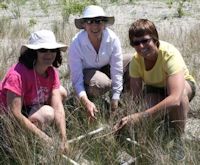OCEAN — Let us take a moment to consider the marshes that surround us.
They are home to rare plants and animals and are nurseries for the fish and shellfish that have become the staples of our dinner table and restaurant menus. That fried flounder and shrimp combo once spent time in a marsh, though sans House Autry and slaw.
Supporter Spotlight
Pretty pictures and paintings of marshes adorn the walls of our homes and businesses, though Hollywood screenwriters haven’t been so kind. The swamp of their imagination is usually a dark and foreboding place. Robert Mitchum stalked Gregory Peck in such a place and Gollum hid with his Precious in one. Giant leeches and crawly creatures rose from them – black lagoons, they were called ominously — to scare a young boy who ignored his mother’s warning and watched those late-night movies anyway.
The movies merely reflected Americans’ attitudes toward the swamps. For much of our history, marshes were considered places of pestilence and danger and given names like Dismal, Great Black and Hell Hole. We did our best to drain them and turn them into something else.
We now know that our marshes occupy special places on the fringes of our watery world. Here, the freshwater of the land meets the salt of the sea. In the resulting briny mix life thrives. So much life, in fact, that the salt marshes of the Southeast coast tend to be the most productive ecosystems in the world.

North Carolina has about 2.5 million acres of estuaries and marine waters. They are among the most productive ecosystems on the planet. Photo: Bill Meserve
Supporter Spotlight
So, not only should we consider them, but maybe we should raise a glass to them. A celebration seems to be in order.
We even have a day to do it. We have days for lovers and mothers, for fathers and their secretaries. We have one for St. Patrick and another for catfish. Why not for marshes?
Though you won’t find a sappy Hallmark card to mark the occasion, Saturday, Sept. 29, is National Estuaries Day – that’s the fancy name for marshes and swamps. Since 1988, the last Saturday in September has been set aside to honor estuaries. Countless activities, involving tens of thousands of people, will go on across the country, from photo contests in Florida to canoe trips in Washington.
Here, on the N.C. coast, the federation will get a jump on the others with estuary day activities on Sat., Sept 22. Whether you like kayaking, biking or just getting dirty, the activities will give you a chance to learn about our marshes and experience them firsthand.
Ocracoke Kayak Trip
 Teachers helped create the marsh that the kayakers will see. |
On Ocracoke, the federation and Ride the Wind Surf Shop will team up to lead a two-hour kayak trip around the island. The kayak trip will begin in Silver Lake Harbor, launching from the N.C. Center for the Advancement of Teaching, at 10 a.m. Kayakers will explore several of the federation’s living shoreline projects, learning about different restoration techniques used to protect the estuaries in Pamlico Sound.
Fees range from $15 to $35 depending on whether you’re a member and if you bring your own kayak. A portion of the proceeds will support the federation’s restoration efforts.
Reservations are required. Call Ride the Wind Surf Shop at 252-928-6311 to sign up.
Atlantic Beach: Cycling for the Coast
Pump up the tires on that old Schwinn or grease the gears on your Cannondale for a ride down Bogue Banks in the federation’s second annual Cycling for the Coast.
 A bicycler in last year’s ride. |
The ride is great for all ages and biking levels, offering 20K, 40K and 80K options. It will begin and end at Fort Macon State Park in Atlantic Beach. Riders will leave in waves, beginning at 8 a.m. with the 80K group; the 40K and 20K riders will leave a little later, biking towards Atlantic Beach and turning around at specified points on the island. Volunteers will assist along the way with safety, snacks and water.
Natty Greene’s Brewing Co. will sponsor an “after party” for riders and sponsors in the Atlantic Beach Circle, beginning around noon.
A portion of the entry fee will support federation restoration projects.
Holly Ridge: Oyster Restoration
If you want to get into the muck of the marshes, head down to Holly Ridge in Onslow County where Ted Wilgis, one of the federation’s educators, will put you to work restoring an oyster reef and marsh in Stump Sound.
Volunteers will fill mesh bags with oyster shells, plant salt marsh grasses along the shoreline and pick up trash and debris on the 52-acre preserve. The federation will supply a Bob-Cat to help with bagging oyster shells and heavy lifting, but many hands will be needed to help cut, seal and stack the bags of shells, gather debris and plant seedlings.







